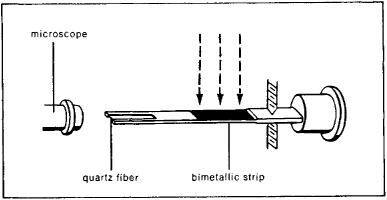actinometer
(ak-tă-nom -ĕ-ter) An instrument for measuring the intensity of radiation.actinometer
[‚ak·tə′näm·əd·ər]Actinometer
an instrument for measuring the intensity of direct solar radiation. The operating principle of an actinometer is based on the absorption of incident radiation by a blackened surface and the conversion of its energy into heat. The actinometer—unlike the pyrheliometer, which is an absolute instrument—is a comparison instrument because the intensity of radiation is judged according to the different phenomena associated with heating. For example, the operating principle of the Mikhel’son actinometer (Figure 1) is based on the heating by the solar rays of a soot-blackened bimetallic strip molded from iron and invar. Upon heating, the iron elongates, but the invar undergoes hardly any thermal expansion, so that the strip buckles. The degree of bending is a measure of the intensity of the solar radiation. By means of a microscope, observations are made on the displacement of a quartz fiber located at the end of the strip.

In the Savinov-Ianishevskii thermoelectric actinometer (Figure 2), the receiving part is a thin silver disk with a blackened outer surface; the central junctions of the thermoelements are cemented to the inner surface of the disk.

They consist of manganine and constantan strips connected in a zigzag fashion (the so-called Savinov star). The peripheral junctions are cemented to a copper ring inside the housing of the actinometer. When the solar rays fall on the receiving surface, the center junctions are heated while the peripheral junctions are shaded. As a result, a thermoelectric current is generated which is proportional to the temperature difference between the center and peripheral junctions, which in turn is proportional to the radiation flux being measured.
REFERENCES
Kondrat’ev, K. Ia. Aktinometriia. Leningrad, 1965.Kedrolivanskii, V. N., and M. S. Sternzat. Meteorologicheskie pribory. Leningrad, 1953.